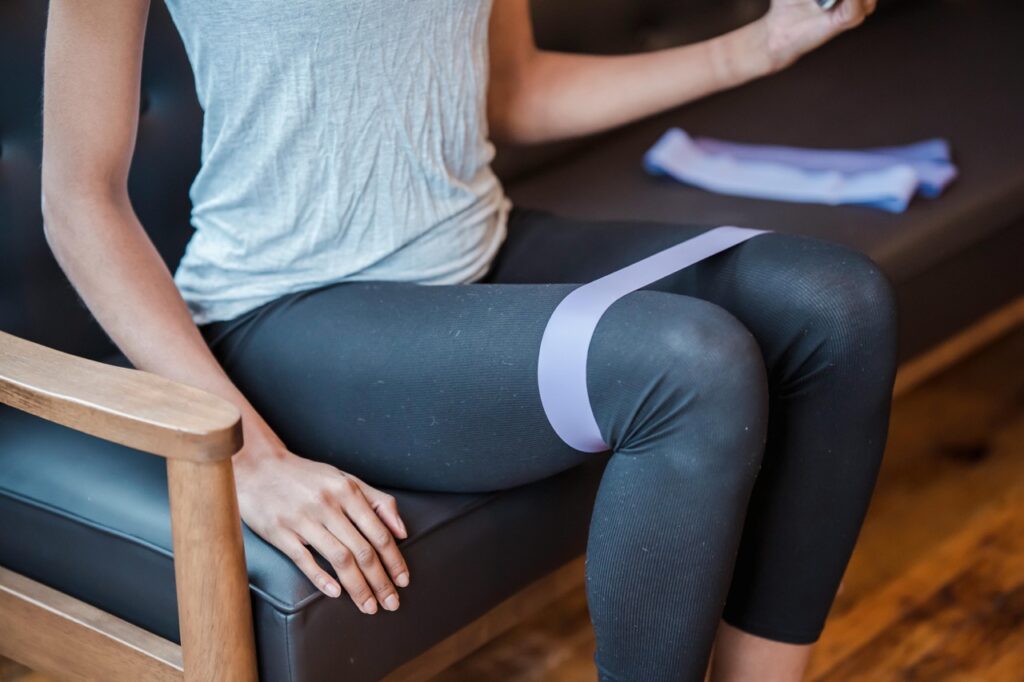In the pursuit of a fit and toned physique, using versatile and efficient workout instruments can make a big impact. Enter the mini-band, the small but powerful accessory that provides a variety of exercises to target every muscle area with precision and intensity. In this article, we’ll reveal how mini-band exercises will help you achieve your fitness goals faster. These dynamic workouts promise to shape lean muscles, improve flexibility, and promote cardiovascular fitness in a short period of time. Join us as we explore a variety of workouts meant to boost your metabolism, contour your body, and take your fitness quest to the next level.

Benefits of Mini-Band Training
Mini-band exercises are an excellent approach to improve muscle activation, increase strength and stability, and help prevent injuries. This section of the article will go over these benefits in further detail.
Improves Muscle Activation
Mini-bands are an effective technique for increasing muscular activation. By adding resistance to exercises, they compel the muscles to work harder, which can aid in strength development and general muscular activation. This is especially crucial for tiny muscles that may be overlooked by regular exercises.
Enhances Strength and Stability
Mini-band workouts can also help you build strength and stability. They can assist improve overall balance and stability by focusing on the core and glutes, which can benefit both athletes and non-athletes. Mini-band exercises can also assist in enhancing hip stability, which is very crucial for runners and other athletes who rely on their hips for power and balance.
Supports Injury Prevention
Finally, mini-band training can be an effective strategy for injury prevention. Mini-band exercises, which target smaller muscles and improve overall muscular activation, can assist in preventing injuries caused by muscle imbalances or deficiencies. Mini-band exercises can also assist in lowering the risk of falls and other injuries caused by poor balance.
Overall, mini-band training is an excellent method for increasing strength, stability, and overall fitness. Mini-band workouts, which target specific muscle groups and promote overall muscular activation, can assist in preventing injuries and improve performance.

Key Mini-Band Exercises
Mini-bands are a versatile and useful tool for increasing resistance throughout your workouts. They can be used to target specific muscle groups and increase overall strength and stability. Here are some of the main mini-band exercises that you can include in your routines:
Lower Body Workouts
Mini-bands are ideal for working the lower body muscles, such as the glutes, hamstrings, and quads. The tiny band squat is a highly effective workout. To do this exercise, wrap the band around your thighs slightly above your knees and stand with your feet hip-width apart. Push your hips back and drop into a squat, keeping your chest high and your knees in line with your toes. Push through your heels to get back up.
Another excellent exercise is the glute bridge, which works the glutes and hamstrings. Lie on your back, legs bent, feet flat on the ground. Place the band around your thighs, about above the knees. Lift your hips to the ceiling, squeezing your glutes at the height of the action.
Upper Body Workouts
Mini-bands can also be utilized to target upper-body muscles like the shoulders, chest, and back. One beneficial workout is the lat pulldown. Attach the band to a strong anchor point above your head, then hold it with your hands shoulder-width apart. Pull the band down to your chest, pulling your shoulder blades together at the bottom of the exercise.
Another excellent workout is the overhead press. Stand on the band, feet hip-width apart, and grip it with your hands at shoulder height. Press the band overhead while keeping your core engaged and your elbows tight to your body.
Core Strengthening Moves
Mini-bands can also be used to target core muscles like the abs and obliques. One useful exercise is the plank with leg abduction. Assume a plank position with the band around your ankles. Lift one leg to the side while maintaining your hips level and core engaged. Lower the leg back down and repeat on the opposite side.
Mountain climbing is another excellent kind of workout. Assume a plank position with the band around your ankles. Bring one knee up to your chest and swiftly switch legs, as if you were sprinting in place. Keep your core engaged and your hips level throughout the action.
Mini-band workouts must be performed with perfect form to avoid injury. Keep your knees aligned with your toes and avoid letting them fold inwards (knee valgus). Use a light to moderate resistance band, gradually increasing the resistance as you gain strength. To achieve the best results, incorporate mini-band movements into your warm-up or main workout regimen.

Incorporating Mini-Bands into Your Routine
Mini-bands are a versatile and cost-effective tool for adding variation and challenge to any workout regimen. Here are some workout programming recommendations, as well as exercise progressions and variations, to help you get the most out of your mini-band exercises.
Workout Programming Tips
When introducing mini-bands into your routine, remember the following programming tips:
- Begin your mini-band workout with a dynamic warm-up consisting of arm circles, leg swings, and bodyweight squats. This will help your body prepare for the upcoming exercises and lessen the danger of damage.
- Choose the right resistance: Mini bands are available in a number of resistance levels, so select a band that provides enough resistance to challenge your muscles while maintaining proper form.
- Progress gradually: As you gain strength, increase the resistance of your mini-band workouts to keep your muscles challenged and progressing.
- Rest between sets: Give your muscles 30-60 seconds to recover and prepare for the next set.
- Seek advice from a fitness professional: If you’re new to mini-band workouts, consult with a fitness professional to guarantee proper form and technique.
Exercise Progressions and Variations
Here are some mini-band exercises and variants that can help you target different muscle areas and advance your workouts:
- Seated hip adduction: Sit on a bench or chair and wrap a mini-band around your ankles. Keeping your feet together, utilize your inner thigh muscles to push your knees out against the resistance of the band.
- Mini-band lateral walk: Wrap a mini-band around your ankles and take short steps to the side, maintaining tension on the band throughout. This exercise works the hip abductors and helps enhance hip stability.
- Mini-band pull-apart: Hold a mini-band in front of your chest, shoulder-width apart. Squeeze your shoulder blades together to separate the band while keeping your arms straight. This exercise focuses on the upper back and can assist improve posture.
- Mini-band ankle overpronation correction: Secure a mini-band to a fixed object and wrap it around your foot. Stand with your feet shoulder-width apart and your knees slightly bent. To correct overpronation, keep your foot flexed and pull the band to the side.
- Mini-band hip internal rotation: Lie on your side, wrapping a mini-band around your knees. Keeping your feet together, push your top knee up and out to the side against the band’s resistance. This exercise focuses on the hip internal rotators and can assist increase groin and pelvic flexibility.
Adding mini-bands to your regimen can help you target various muscle groups.

Safety and Maintenance
Correct Usage and Form
To avoid injury when exercising with mini-bands, good form and technique are required. It is advised that you meet with a personal trainer to acquire the proper movement patterns and techniques for each exercise. Incorrect form can induce knee valgus, resulting in knee and hip injuries.
Hip stability is essential when utilizing mini-bands. When doing exercises like glute kickbacks or hip abduction, maintain your hips level and avoid plantar flexion. This guarantees that the glute muscles are addressed and the exercise is carried out appropriately.
Caring for Your Mini-Bands
Mini resistance bands must be properly cared for and maintained to ensure their longevity. After each use, wipe them down with a moist cloth to eliminate any sweat or grime. Avoid exposing them to direct sunlight or high temperatures, since these might harm the bands.
When storing mini-bands, keep them cold and dry, and avoid folding them. Instead, wrap them up and tie them with a rubber band or clip to keep them from getting tangled.
Using mini-bands in conjunction with free weights can result in an efficient workout that targets many muscle groups. To avoid damage, employ appropriate form and gradually increase the resistance.
Overall, utilizing mini-bands for exercise can be a safe and effective technique to target specific muscle areas while increasing overall fitness. Individuals who follow proper form and maintenance requirements can avoid injuries and maximize the advantages of mini-band activities.
Conclusion
In conclusion, mini-band workouts are a time-saving and effective way to get a healthy and toned physique. Individuals can sculpt muscles, build strength, and improve overall fitness levels in a fraction of the time it takes to do regular workouts by utilizing the resistance produced by these small yet formidable bands. Whether you’re a beginner or an experienced fitness enthusiast, including mini-band exercises in your program can provide quick and visible results. Remember to begin cautiously, listen to your body, and maintain consistency in your efforts. With dedication and patience, you’ll be well on your way to meeting your fitness objectives and enjoying a healthier, stronger body.
Trusted Health, Wellness, and Medical advice for your well-being


